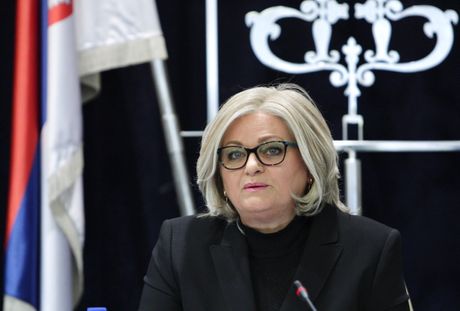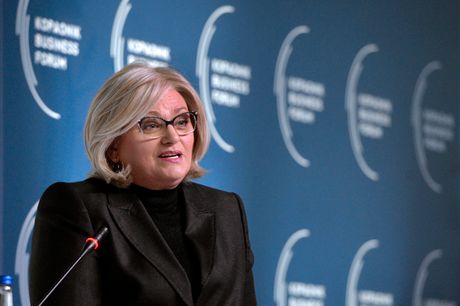National Bank of Serbia again raises key policy: How does this affect loans?

At today's meeting, the Executive Board of the National Bank of Serbia (NBS) decided to increase the reference interest rate by 50 bp to 4%. %. The rates on deposit and credit facilities were also raised by 50 bp, to 3% and 5%.
Key rate affects dinar loans the most
During the previous months, starting in April, the NBS raised the key interest rate three times, starting with half a percent, then twice by a quarter, and last month by another half. The reference rate has reached 3.5 percent from one.
This rate influences the price of dinar loans with variable interest the most, which have already become significantly more expensive in recent months.
As economists told Telegraf Biznis earlier, not only are new loans that clients are just applying for less favorable, but loans that are being repaid are also more expensive.
The NBS explains the decision
Amid continued, primarily global, cost-push pressures and rising imported inflation, the Executive Board voted to further raise the key policy rate and continue to tighten monetary conditions.
By making such decision, in an environment of the prevailing inflationary impact of supply-side factors on which monetary policy measures have little or no influence at all, the NBS aims to contain the inflationary effect of demand-side factors and the second-round effects of rising food and energy prices on other prices through inflation expectations.
The NBS strives to ensure that inflation hits a downward trajectory and returns within the target tolerance band until the end of the projection horizon. The Executive Board highlighted that the NBS has been incrementally but continuously tightening monetary conditions in the domestic market since October last year, while also focusing on economic growth.
Today’s increase in the key policy rate is the seventh in a row. Since April this year, the rate has been raised by 300 bp. In addition to raising the main interest rates and tightening the conditions of dinar liquidity, the NBS significantly contributes to price stability in the medium run by maintaining the relative stability of the dinar exchange rate against the euro, by limiting the spillover of elevated import prices on domestic prices.
The Board expects inflation to move largely in line with the latest, August NBS projection, according to which y-o-y inflation will peak most probably in September and decline below its current figure by the year end. It is expected to continue down in the course of next year, and return within the target band by the end of the projection horizon. Inflationary pressures will subside owing to past monetary tightening, the expected waning of the effects of global factors driving up the energy and food prices in the past period, and lower external demand amid a gloomier global growth outlook. In the near term, inflationary pressures will calm also on account of the government economic measures capping the rise in food and energy prices in the domestic market.
"In an environment of global slowdown and mounting recessionary pressures in the euro area, our most important economic partner, we anticipate that domestic economic activity will slow in the remainder of this and early next year. In H1 2022 the GDP growth rate was relatively high, at 4.1% y-o-y. At the year-level, the Executive Board projects it will move within a 3.5–4.5% range, though there are downside risks stemming from potentially weaker than expected growth in the euro area and our other important trade partners, including a less favorable agricultural season at home. However, as assessed by the Executive Board, stronger export supply, supported by investment in tradable sectors in earlier years, will offset, to an extent, the effect of dented external demand on manufacturing exports, as confirmed by the continued, two-digit y-o-y growth in goods exports in July and August," the NBS said.
When making the decision, the Executive Board was aware that geopolitical developments and escalation of the conflict in Ukraine drove global energy and primary commodity prices to their maximum levels in H1 this year, thus leading to further growth in global inflation. Against such backdrop, over the past months a number of central banks tightened their monetary policies more dynamically than initially expected, revising up their inflation projections, as well as expectations as to the maximum level inflation would reach and when it should reach it. In September the European Central Bank opted for the highest increase in its main refinancing rate ever (75 bp), and a similar hike is expected in October, too.
This is also indicated by the fact that euro area inflation continued up to its new historic maximum (two-digit level in September). The Fed also raised its federal funds rate to the same extent in September. Monetary policy tightening is expected to continue going forward, given the expectations that inflation in the euro area and the US is not likely to return within the target tolerance band before 2024.

Coupled with unfavorable prospects of global economic growth, a further tightening in the Fed’s and ECB’s monetary policies may result in increased volatility in the international financial market and the continuation of the already present rerouting of global capital flows from developing to more advanced economies. Elevated recession pressures globally drove the global prices of oil and other primary commodities down over the previous months; however, these prices are still volatile and at a significantly higher level than a year ago. Uncertainty is particularly high in relation to the availability of natural gas in Europe and its price during winter due to the additional exacerbation of geopolitical tensions.
Inflation in Serbia continues to rise, fuelled by the significant hike in global energy prices and a relatively high imported inflation, coupled with the effects of drought in the local market and most of Europe which are driving food prices further up. Y-o-y inflation measured 13.2% in August, around 70% of the increase still being attributable to food and energy prices. Higher imported inflation also reflected on higher core inflation (headline inflation excluding the prices of food, energy, alcohol and cigarettes) that reached 7.9% y-o-y in August.
It is important to note that core inflation remains much lower than headline inflation, as well as than core inflation experienced by regional peers running the same monetary policy regime. The lower core inflation continues to be underpinned by the preserved relative stability of the exchange rate in extremely uncertain global conditions and the anchored medium-term inflation expectations of the financial sector, moving within the bounds of the target.
Depending on the global geopolitical situation and movement in key monetary and macroeconomic factors from the domestic and international environment in the period ahead, the NBS will assess if there is a need for further monetary tightening. The maintenance of price and financial stability remains the monetary policy priority in the medium term, with support to further economic growth.
Video: Tabakovic: We are making an effort to prevent possible negative phenomena in the phase of introducing new services
(Telegraf Biznis)
Video: Ambasada obeležila Dan nezavisnosti, prisustvovala Ana Brnabić i članovi Vlade
Telegraf.rs zadržava sva prava nad sadržajem. Za preuzimanje sadržaja pogledajte uputstva na stranici Uslovi korišćenja.

